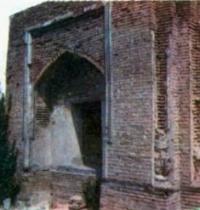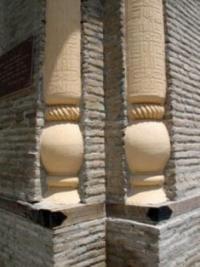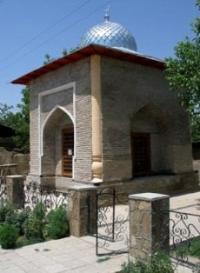Вы здесь
Mausoleum of Khoja Talig.



Guide to Sairam.
“Does progress mean that we dissolve our ancient myths? If we forget our legends, I fear that we shall close an important door to the imagination”
James Christensen.
The ancient mausoleums and mosques of Sairam.
Sayram was the birthplace of the great prophet and Sufi teacher Khoja Ahmed Yasavi, and the tomb of his mother Karashash can be seen here. An architectural highlight is the 15-metre-high Hisr Paygambar Minaret, part of the Xth century Kyzyr mosque.
There is also a Museum of History, which contains an old, richly illustrated Koran and stone support from the original Friday mosque. The Koran dates back 200 years, but the stone support is believed to be from that same original mosque, though it has not been carbon dated to support that theory.
Most of the historical sites lie at the edge of the town, which is 20 kilometres east of Shymkent, along the road to Lenger. Sayram has a high population density of Uzbeks, and there is relatively little Russian influence here - it has a very Central Asian feel to it and is strongly Islamic, with the Muslim call to prayers echoing out over the rooftops more noticeably than in larger cities like Shymkent.
The Khoja Talig Mausoleum was built in the XIXth century. It is located in the center of the village of Sairam in the Sairam district of the Turkestan region, 300 meters from the intersection of the main streets, surrounded by residential buildings.
According to legend, it was built over the burial of a local sheikh. In the XVII - XVIII centuries, a tomb of the saint was built, the building of which was repeatedly rebuilt (the original appearance was not preserved).
The modern building dates back to the 2nd half of the XIXth century. It is made of bricks of different sizes - 350 x 170 x 150 mm, 160 x 340 x 50 mm, 230 x 230 x 40 mm. Bricks for the building were taken, disassembling other structures.
The foundation and the base are brick. External walls are not plastered. The single-chamber square mausoleum is covered by a low, almost flat spherical dome, in the center of which a small tower is erected, also covered by a dome with a hole.
Facades are equivalent. Decorated with portals with shallow niches in a U-shaped frame. The corners of the portals are divided by vertical ledges with curly columns. Corrugated barrel trunks are not preserved. In the interior, the main dome rests on 4 arches, which also rest on 4 powerful pylons.
The window openings are lined with a modern panjar grating. The walls are not plastered. It has been restored in its modern form and the dome is covered with tin.
Authority:
"Code of monuments of the South Kazakhstan region." Architectural and archaeological heritage of the South Kazakhstan region. In the framework of the regional program "Cultural Heritage". http://www.farsah.kz







